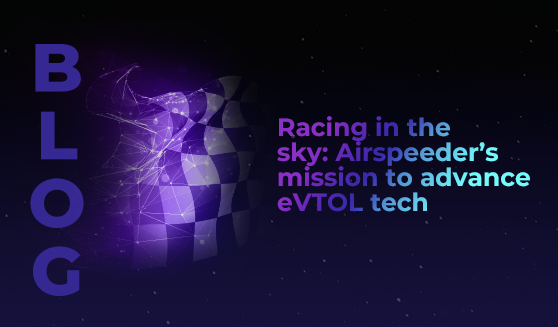
Top trends to watch in the smart cities market
Explore key smart city market trends for 2025–2030, from EV infrastructure to AI-powered waste systems – backed by the latest industry report.


It’s not every day that you land on your next big idea while you’re trekking on horseback through Mongolia. But that’s exactly what happened for Jack Withinshaw (Founder and CEO at Airspeeder).
Together with co-founder Matthew Pearson, Withinshaw is pushing the boundaries of what’s possible in the electric aircraft space – with a racing series that highlights the potential of electric vertical take-off and landing aircraft (eVTOLs), and aims to drive innovation that will expedite the rollout of eVTOLs for commercial use.
Withinshaw joined us in Riyadh to speak at LEAP 2024. But just before he arrived, we asked him for a quick glimpse into the story behind Airspeeder – exclusively for the LEAP blog.
“At university, I studied Philosophy and Ancient History, two subjects you don't often find on the CV's of those in the Aerospace industry. I spent the following years working in media, marketing, and advertising sales, for both startups and medium-sized corporations, across Australia and the UK.
“In late 2015, I was trekking on horseback through the northern regions of Mongolia with Matt Pearson when he pitched me an idea for a flying car racing league. I immediately loved the underlying philosophy that all mobility revolutions have started with racing, and it's likely going to be the same for eVTOLs.
“Maybe it was because I was a student of history, but I couldn't shake the idea that if we could accelerate UAM (Urban Air Mobility) through racing, it could have a seismic and generational impact on the world. To me, that alone seemed like a worthy challenge. I said if he was able to scale vehicles up from subscale drones, then I should be able to help scale the business model.
“I joined Matt on the journey to do just that in 2019, and we haven't looked back since.”
“The reason we built Airspeeder was to accelerate the vision of Urban Air Mobility. To provide the industry with a place and a space to test, develop, and innovate core technologies that would underpin this newly booming industry. To open up the vertical space and redefine motorsports for the next generation.
“To build this vision, we needed craft to race in the series, so Matt founded Alauda Aeronautics in 2016, the world's first performance eVTOL Aerospace company, responsible for building the race vehicles that compete within the series.”
“In the past 12 months we've held two EXA Series (External Aviator) races in Australia, with three full-scale speeders racing head to head on augmented reality sky tracks. This world-first moment featured a full broadcast crew, VIP hospitality, and partner activations, as well as the first race in which Bruno Senna competed.
“We've supported the launch of an Airspeeder Esports division (Celeros), which has hosted its first online tournaments. We've signed global partnerships with Intel, joining as our Official Intelligence partner, released a broadcast series on DAZN and Fox Sports, and lastly, we've launched our first crewed racing vehicle, the Mk4 Airspeeder.
“Having proven the reality and viability of Flying Car Racing, we've now started engaging international host locations and automotive OEM teams to join the growth of this new sport.”
“We can race across deserts, over and around mountains, skimming across ice, snow, grass, or water. Our race infrastructure is primarily digital, with no need for costly tarmac racing tracks, which leaves our race locations almost untouched. We've designed our infrastructure to be modular, allowing us to expand the series globally.
“We like to race in remote locations to showcase these environments, while also enabling the safety case associated with nascent technology and a new racing series. Weather-wise, light winds and blue skies are an Airspeeder pilot's dream – but we can (and have) raced in far more testing conditions.
“As a sport, we believe there is an incredible opportunity in taking this series globally with international circuits but even more so, for the audience at home. Considering the range of various technologies that are being utilised, spanning private 5G, multiple onboard cameras, Augmented Reality tracks, remote cockpits, plus a ballet of film and chase drones, this digitally enabled sport is ripe for broadcast viewing.”
“Historically, motorsports have excelled in three things: driving technological development, driving safety technologies, and driving awareness, acceptance, and adoption for new forms of mobility. Airspeeder will do just that for the booming Urban Air Mobility revolution, enabling and accelerating opportunities for Air Taxis globally.
“Over a century ago, at the dawn of the automotive era, racing was one of the first applications for this new four-wheeled technology. In a time when there were no roads, gas pumps, or driver's licences, they were racing on the track.
“Names like Marcel Renault of Renault, Charles Rolls of Rolls Royce, Henry Ford, or Enzo Ferrari all started as racers. From racing, they built their name, their brand and the technical craftsmanship to then move into the commercial space.
“We are the platform that is allowing the same types of Automotive OEMs to do it all over again, but this time, to race in the vertical space.”
“I have two that jump to mind. One, starting with an outlandish/impossible idea is great (that's where true disruption is found), but the very next step is the hardest: taking the leap and getting started.
“From there, it gets easier as you take each step one at a time, slowly proving the impossible is possible and eventually turning that idea into a reality.
“The second is that the world will constantly try to push back on outlandish or impossible; it doesn't necessarily want to change. That's how you know you're heading in the right direction.”
“It may be because I'm from the world of racing, but I see the world moving and changing faster than ever before. It's imperative to take a moment to look around, read the pulse of the wider technology industry, and see how it could accelerate your business, your clients' business, and your growth path. Events like LEAP allow us to see the technologies that will change our world start to make their way over the horizon.”
Thanks to Jack Withinshaw at Airspeeder. Did you miss LEAP 2024? Don’t worry! Watch this space – pre-registration for LEAP 2025 will open soon.

Explore key smart city market trends for 2025–2030, from EV infrastructure to AI-powered waste systems – backed by the latest industry report.

Learn how generative AI is unlocking the true potential of digital twins – to make smart cities more efficient, inclusive, and citizen-focused.

The smart cities of the future will use tech to lower emissions, cut urban temperatures, and improve quality of life in highly populated areas.

Explore key smart city market trends for 2025–2030, from EV infrastructure to AI-powered waste systems – backed by the latest industry report.

Learn how generative AI is unlocking the true potential of digital twins – to make smart cities more efficient, inclusive, and citizen-focused.

The smart cities of the future will use tech to lower emissions, cut urban temperatures, and improve quality of life in highly populated areas.